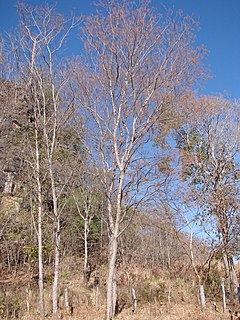
The Cerrado is a vast tropical savanna ecoregion of Brazil, particularly in the states of Goiás, Mato Grosso do Sul, Mato Grosso, Tocantins, Minas Gerais and the Federal District. The core areas of the Cerrado biome are the Brazilian highlands, the Planalto. The main habitat types of the Cerrado consist of forest savanna, wooded savanna, park savanna and gramineous-woody savanna. Savanna wetlands and gallery forests are also included. The second largest of Brazil's major habitat types, after the Amazonian rainforest, the Cerrado accounts for a full 21 percent of the country's land area.
Justicia angustifolia is a plant native to the Cerrado vegetation of Brazil.
Justicia burchellii is an ornamental plant native of Cerrado vegetation of Brazil.

Justicia irwinii is a plant native to the Cerrado vegetation of Brazil.
Justicia riparia is a plant native to the Cerrado vegetation of Brazil.
Justicia sarithroides is a plant native to the Cerrado vegetation of Brazil.
Justicia serrana is a plant native to the Cerrado vegetation of Brazil.
Justicia warmingii is a plant native to the Cerrado vegetation of Brazil.
Teliostachya alopecuroidea, the pata de gallina, is a plant native of Cerrado vegetation of Brazil.
Jacobinia macedoana is a plant native of Cerrado vegetation of Brazil.
Justicia tocantina is a plant native to Argentine, and the Cerrado vegetation of Brazil. This plant is cited in Flora Brasiliensis by Carl Friedrich Philipp von Martius.
Ruellia capitata is a plant native to Cerrado vegetation of Argentina, Brazil, and Paraguay.
Ruellia dissitifolia is a plant native to the Cerrado vegetation of Brazil.
Ruellia diffusa is a plant native to the Cerrado vegetation of Brazil.
Aspidosperma dasycarpon is a tree native to Brazil, which is typical in Cerrado vegetation. This plant is cited in Flora Brasiliensis by Carl Friedrich Philipp von Martius. In addition, it is useful for beekeeping.

Myracrodruon urundeuva is a timber tree, which is often used for beekeeping. This plant is native from Argentina, Brazil, Bolivia and Paraguay, and it is typical of Caatinga, Cerrado, and Pantanal vegetation in Brazil.

Anadenanthera peregrina var. falcata is a timber tree native to Paraguay and Cerrado vegetation in Brazil, specially in Mato Grosso, Mato Grosso do Sul, Minas Gerais, and São Paulo. This plant is also used as an ornamental.

Chamissoa altissima, or false chaff flower, is native to North and South America. In Brazil it grows in the Cerrado vegetation.
Alchornea triplinervia is a commercial timber tree native to Amazon Rainforest, Atlantic Forest, and Cerrado vegetation in Brazil. This plant is found in the following states of Brazil: Amazonas, Bahia, Espírito Santo, Goiás, Mato Grosso, Mato Grosso do Sul, Minas Gerais, Paraná, Rio de Janeiro, Rio Grande do Sul, Rondônia, Roraima, Santa Catarina, and São Paulo. It is also used as a honey plant.

According to IBGE (2004), Brazil has its territory occupied by six terrestrial biomes and one marine biome.
This page is based on this
Wikipedia article Text is available under the
CC BY-SA 4.0 license; additional terms may apply.
Images, videos and audio are available under their respective licenses.






